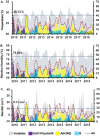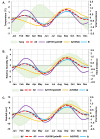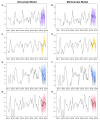Climate factors influence seasonal influenza activity in Bangkok, Thailand
- PMID: 32991630
- PMCID: PMC7523966
- DOI: 10.1371/journal.pone.0239729
Climate factors influence seasonal influenza activity in Bangkok, Thailand
Abstract
Yearly increase in influenza activity is associated with cold and dry winter in the temperate regions, while influenza patterns in tropical countries vary significantly by regional climates and geographic locations. To examine the association between influenza activity in Thailand and local climate factors including temperature, relative humidity, and rainfall, we analyzed the influenza surveillance data from January 2010 to December 2018 obtained from a large private hospital in Bangkok. We found that approximately one in five influenza-like illness samples (21.6% or 6,678/30,852) tested positive for influenza virus. Influenza virus typing showed that 34.2% were influenza A(H1N1)pdm09, 46.0% were influenza A(H3N2), and 19.8% were influenza B virus. There were two seasonal waves of increased influenza activity. Peak influenza A(H1N1)pdm09 activity occurred in February and again in August, while influenza A(H3N2) and influenza B viruses were primarily detected in August and September. Time series analysis suggests that increased relative humidity was significantly associated with increased influenza activity in Bangkok. Months with peak influenza activity generally followed the most humid months of the year. We performed the seasonal autoregressive integrated moving average (SARIMA) multivariate analysis of all influenza activity on the 2011 to 2017 data to predict the influenza activity for 2018. The resulting model closely resembled the actual observed overall influenza detected that year. Consequently, the ability to predict seasonal pattern of influenza in a large tropical city such as Bangkok may enable better public health planning and underscores the importance of annual influenza vaccination prior to the rainy season.
Conflict of interest statement
The authors have declared that no competing interests exist.
Figures





References
-
- Troeger CE, Blacker BF, Khalil IA, Zimsen SR, Albertson SB, Abate D, et al. Mortality, morbidity, and hospitalisations due to influenza lower respiratory tract infections, 2017: an analysis for the Global Burden of Disease Study 2017. Lancet Respir Med. 2019;7(1):69–89. 10.1016/S2213-2600(18)30496-X. . - DOI - PMC - PubMed
-
- Kamigaki T, Chaw L, Tan AG, Tamaki R, Alday PP, Javier JB, et al. Seasonality of Influenza and Respiratory Syncytial Viruses and the Effect of Climate Factors in Subtropical–Tropical Asia Using Influenza-Like Illness Surveillance Data, 2010–2012. PLoS One. 2016;11(12):e0167712 10.1371/journal.pone.0167712. . - DOI - PMC - PubMed
Publication types
MeSH terms
Substances
LinkOut - more resources
Full Text Sources
Medical

